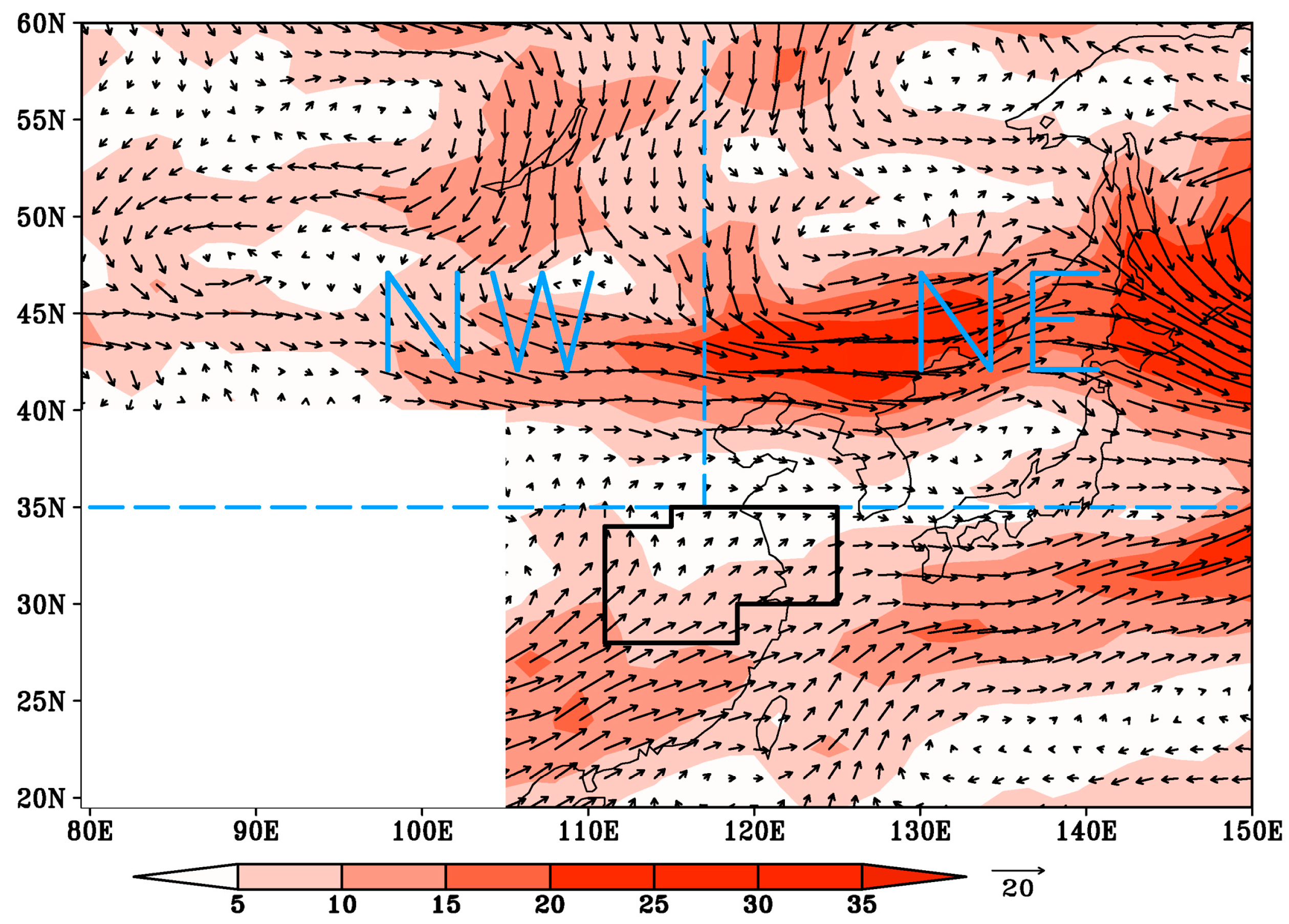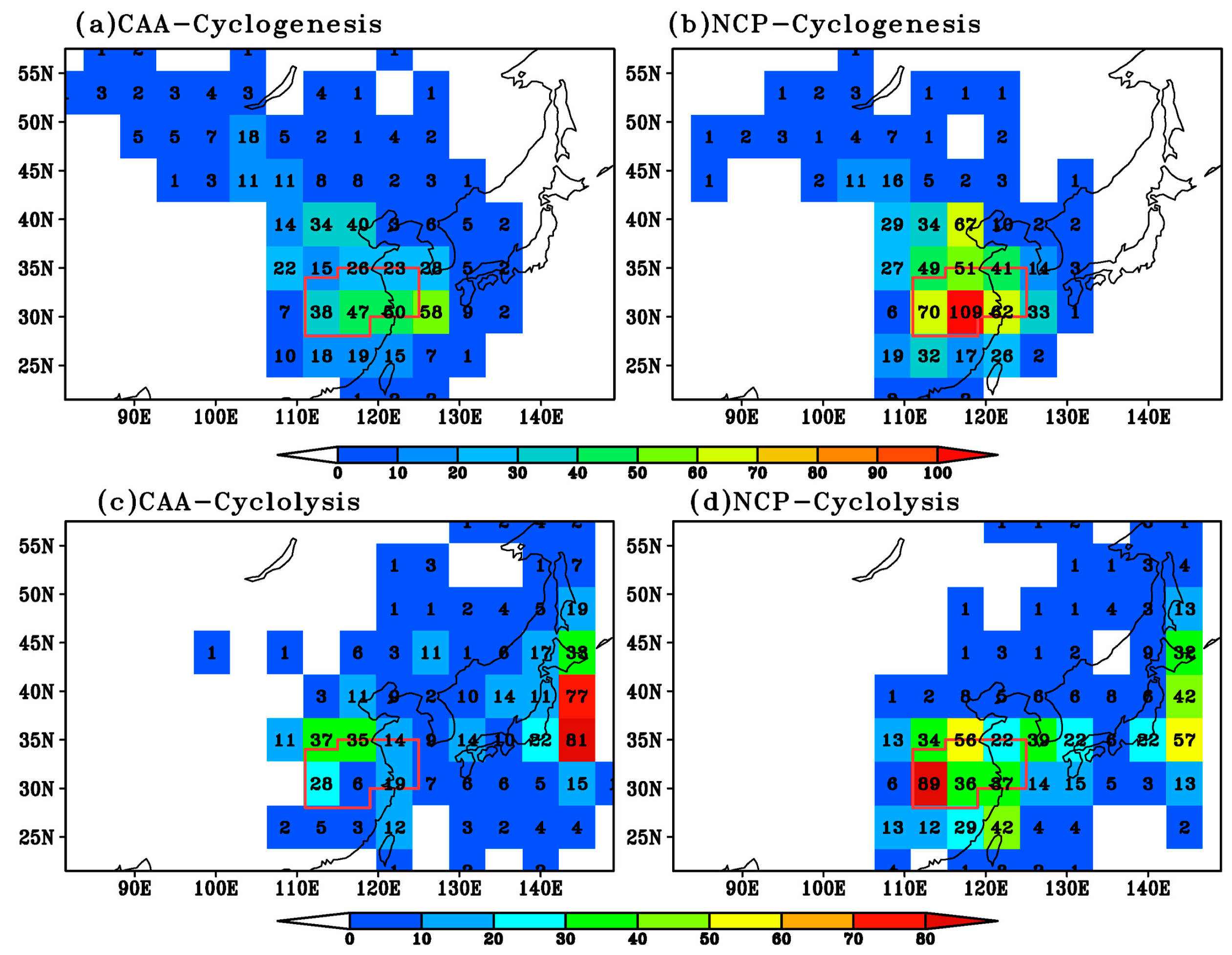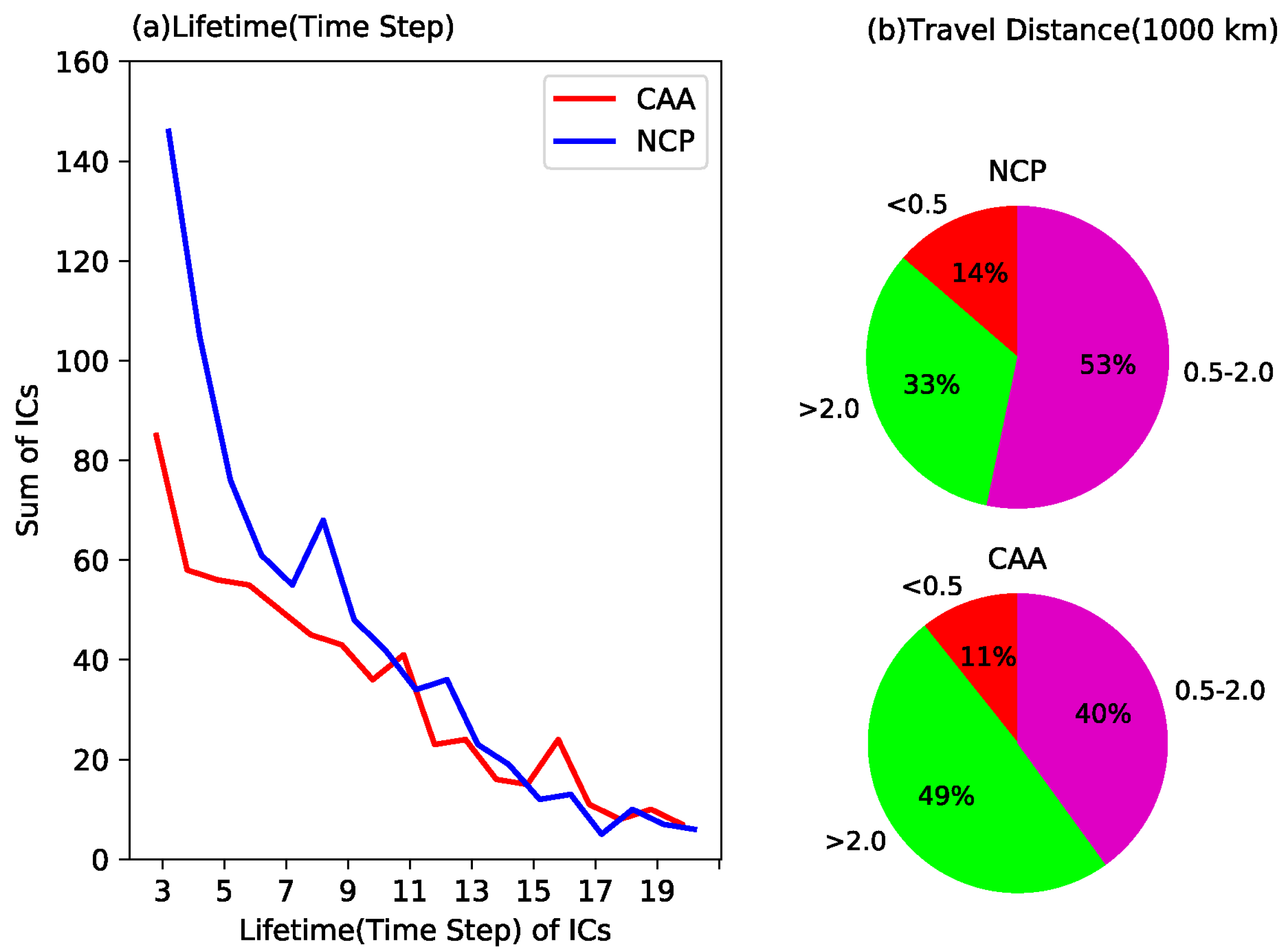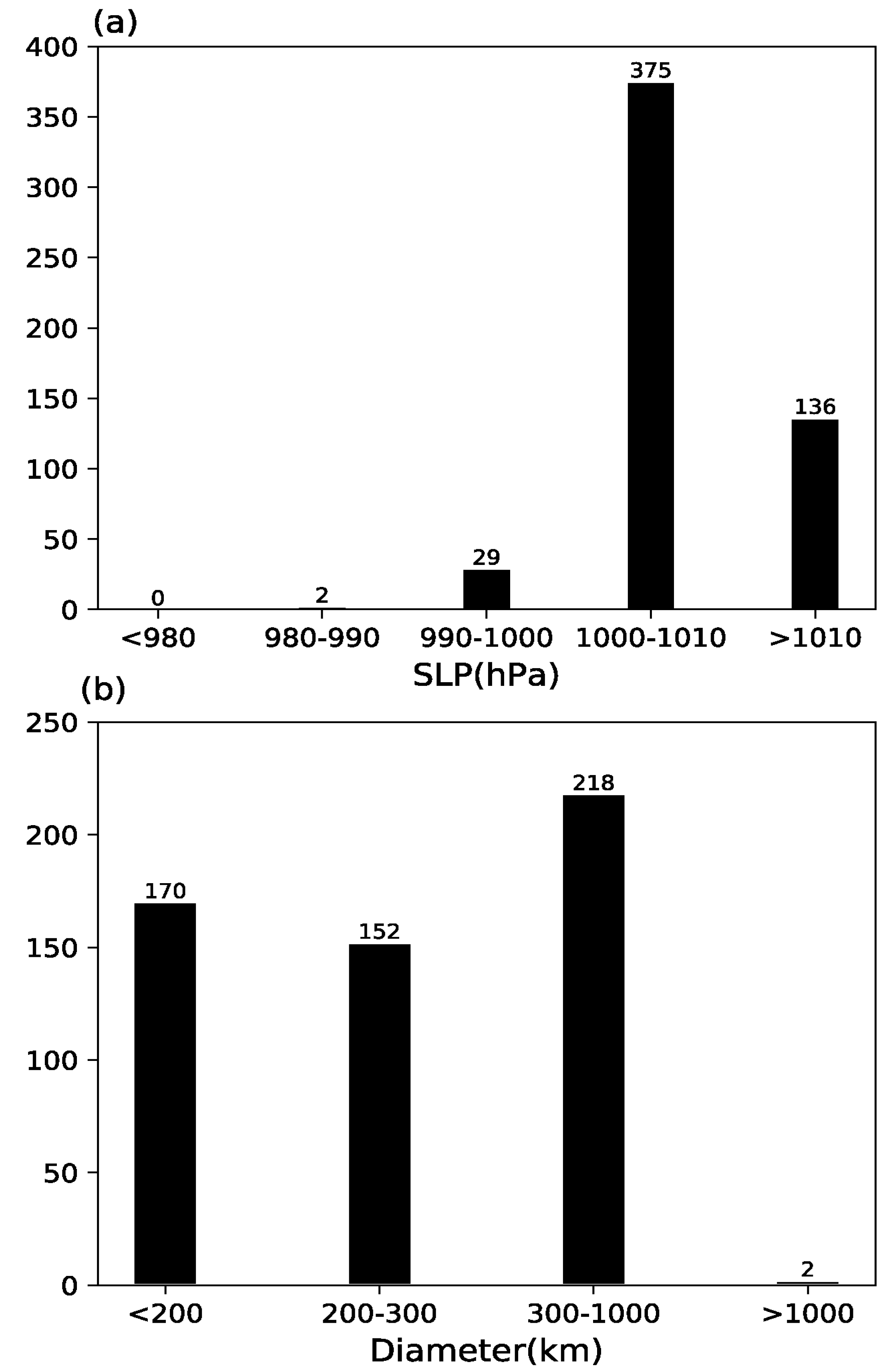Comparison of Two Automatic Identification Algorithms for Cyclones Affecting the Changjiang River–Huaihe River Valleys
Abstract
1. Introduction
2. Data and Method
2.1. Data
2.2. Methods of Cyclone Identification
3. Characteristics of ICs by Two Algorithms
3.1. IC Tracks
3.2. Cyclogenesis and Cyclolysis of ICs
4. Comparison of IC Climatology Using the Two Algorithms
4.1. Climatological IC Frequencies
4.2. Lifetime, Travel Distance and Intensity
5. Sensitivity of the Two Algorithms to the Dataset Resolution
6. Characteristics of ICs with Short Lifetimes
7. Conclusions
- The frequency of ICs was comparable between the CAA and NCP. However, only <46% of cyclones shared the same cyclone center between these two schemes. The exclusion of open systems and marking a multicenter cyclone as a whole system resulted in the inconsistency in cyclone center location and a lower frequency of cyclones under the CAA. On the other hand, a supplementary set of ICs (51%) was detected in the CAA because of their cyclone regime affecting CHV with their cyclone center point outside the CHV.
- ICs derived using the CAA had typically longer lifetimes and travel distances, with stronger center intensities than those in the NCP. More cyclones coming from midlatitudes were detected under the CAA, and these cyclones usually had stronger intensities and longer lifetimes. Furthermore, the involvement of open systems in the NCP resulted in a weaker center-SLP under the NCP than the CAA.
- Two different horizontal resolution SLPs were applied to cyclone detection using the NCP and the CAA. The track of ICs under the CAA with high resolution showed good agreement with that of ICs using the low-resolution CAA, as well as the low-resolution NCP. However, a substantially increased number of open systems were detected using the high-resolution NCP. Due to the interference of these open local minimums, using the high-resolution NCP, 50% of the tracks of the 10 ICs with the lowest center-SLP presented large deviations during their early stage compared to those identified using other methods.
Author Contributions
Funding
Acknowledgments
Conflicts of Interest
References
- Trenberth, K.E.; Owen, T.W. Workshop on Indices and Indicators for Climate Extremes, Asheville, NC, USA, 3–6 June 1997 Breakout Group A: Storms. Clim. Chang. 1999, 42, 9–21. [Google Scholar] [CrossRef]
- Yingxian, Z.; Yihui, D.; Qiaoping, L. A Climatology of Extratropical Cyclones over East Asia During 1958–2001. Acta Meteorol. Sin. 2012, 26, 261–277. [Google Scholar]
- Chao, H.; Zhaoyong, G.; Minggang, L. The seasonal cycle of redistribution of atmospheric mass between continent and ocean in the Northern Hemisphere. Sci. China 2014, 57, 1501–1512. [Google Scholar]
- Reale, M.; Lionello, P. Synoptic climatology of winter intense precipitation events along the Mediterranean coasts. Nat. Hazards Earth Syst. Sci. 2013, 13, 1707–1722. [Google Scholar] [CrossRef]
- Toreti, A.; Xoplaki, E.; Maraun, D.; Kuglitsch, F.G.; Wanner, H.; Luterbacher, J. Characterisation of extreme winter precipitation in Mediterranean coastal sites and associated anomalous atmospheric circulation patterns. Nat. Hazards Earth Syst. Sci. 2010, 10, 1037–1050. [Google Scholar] [CrossRef]
- Lijuan, W.; Chao, W.; Dong, G. Evolution mechanism of synoptic-scale EAP teleconnection pattern and its relationship to summer precipitation in China. Atmos. Res. 2018, 214, 150–162. [Google Scholar]
- Jiaxi, C.; Zhaoyong, G.; Fenhua, M. Possible Combined Influences of Absorbing Aerosols and Anomalous Atmospheric Circulation on Summertime Diurnal Temperature Range Variation over the Middle and Lower Reaches of the Yangtze River. J. Meteorol. Res. 2016, 30, 927–943. [Google Scholar]
- Murray, R.J.; Simmonds, I. A numerical scheme for tracking cyclone centres from digital data. Part II: Application to January and July general circulation model simulations. Aust. Meteorol. Mag. 1991, 39, 167–180. [Google Scholar]
- Hodges, K.I. A General Method for Tracking Analysis and Its Application to Meteorological Data. Mon. Weather Rev. 1994, 122, 2573–2586. [Google Scholar] [CrossRef]
- Xiangdong, Z.; Walsh, J.E.; Jing, Z.; Bhatt, U.S.; Ikeda, M. Climatology and Interannual Variability of Arctic Cyclone Activity: 1948–2002. J. Clim. 2004, 17, 2300–2317. [Google Scholar]
- Wernli, H.; Schwierz, C. Surface Cyclones in the ERA-40 Dataset (1958–2001). Part I: Novel Identification Method and Global Climatology. J. Atmos. Sci. 2006, 63, 2486–2507. [Google Scholar] [CrossRef]
- Rudeva, I.; Gulev, S.K. Climatology of Cyclone Size Characteristics and Their Changes during the Cyclone Life Cycle. Mon. Weather Rev. 2007, 135, 2568–2587. [Google Scholar] [CrossRef]
- Xinmin, W.; Panmao, Z.; Cuicui, W. Variations in Extratropical Cyclone Activity in Northern East Asia. Adv. Atmos. Sci. 2009, 26, 471–479. [Google Scholar]
- Wang, L.; Dai, Z.; He, J. Numerical simulation of the relationship between the maintance and increase in heavy rainfall of the landing tropical storm BILIS and moisture transport from lower latitudes. J. Trop. Meteorol. 2017, 23, 47–57. [Google Scholar]
- Jin, D.; Huo, L. Influence of tropical Atlantic sea surface temperature anomalies on the East Asian summer monsoon. Q. J. R. Meteorol. Soc. 2018. [Google Scholar] [CrossRef]
- Serreze, M.C.; Carse, F.; Barry, R.G.; Rogers, J.C. Icelandic Low Cyclone Activity: Climatological Features, Linkages with the NAO, and Relationships with Recent Changes in the Northern Hemisphere Circulation. J. Clim. 1995, 10, 453–464. [Google Scholar] [CrossRef]
- Inatsu, M. The neighbor enclosed area tracking algorithm for extratropical wintertime cyclones. Atmos. Sci. Lett. 2009, 10, 267–272. [Google Scholar] [CrossRef]
- Neu, U.; Akperov, M.G.; Bellenbaum, N.; Benestad, R.; Blender, R.; Caballero, R.; Cocozza, A.; Dacre, H.F.; Feng, Y.; Fraedrich, K. IMILAST: A Community Effort to Intercompare Extratropical Cyclone Detection and Tracking Algorithms. Bull. Am. Meteorol. Soc. 2013, 94, 529–547. [Google Scholar] [CrossRef]
- Simmonds, I. Size Changes over the Life of Sea Level Cyclones in the NCEP Reanalysis. Mon. Weather Rev. 1999, 128, 4118–4125. [Google Scholar] [CrossRef]
- Kouroutzoglou, J. On the vertical structure of Mediterranean explosive cyclones. Theor. Appl. Climatol. 2012, 110, 155–176. [Google Scholar] [CrossRef]
- Chuhan, L. A modified algorithm for identifying and tracking extratropical cyclones. Adv. Atmos. Sci. 2017, 34, 909–924. [Google Scholar]
- Hodges, K.I.; Lee, R.W.; Bengtsson, L. A Comparison of Extratropical Cyclones in Recent Reanalyses ERA-Interim, NASA MERRA, NCEP CFSR, and JRA-25. J. Clim. 2011, 24, 4888–4906. [Google Scholar] [CrossRef]
- Tilinina, N.; Gulev, S.K.; Rudeva, I.; Koltermann, P. Comparing Cyclone Life Cycle Characteristics and Their Interannual Variability in Different Reanalyses. J. Clim. 2013, 26, 6419–6438. [Google Scholar] [CrossRef]
- Rudeva, I.; Gulev, S.K.; Simmonds, I.; Tilinina, N. The sensitivity of characteristics of cyclone activity to identification procedures in tracking algorithms. Tellus Ser. A Dyn. Meteorol. Oceanogr. 2014, 66, 24961. [Google Scholar] [CrossRef]
- Simmonds, I.; Rudeva, I. A comparison of tracking methods for extreme cyclones in the Arctic basin. Tellus Ser. A Dyn. Meteorol. Oceanogr. 2014, 66, 25252. [Google Scholar] [CrossRef]
- Hewson, T.D.; Neu, U. Cyclones, windstorms and the IMILAST project. Tellus 2015, 67, 27128. [Google Scholar] [CrossRef]
- Lionello, P.; Trigo, I.F.; Gil, V.; Liberato, M.L.R.; Nissen, K.M.; Pinto, J.G.; Raible, C.C.; Reale, M.; Tanzarella, A.; Trigo, R.M. Objective climatology of cyclones in the Mediterranean region: A consensus view among methods with different system identification and tracking criteria. Tellus Ser. A Dyn. Meteorol. Oceanogr. 2016, 68, 29391. [Google Scholar] [CrossRef]
- Flaounas, E.; Kelemen, F.D.; Wernli, H.; Gaertner, M.A.; Reale, M.; Sanchez-Gomez, E.; Lionello, P.; Calmanti, S.; Podrascanin, Z.; Somot, S. Assessment of an ensemble of ocean–atmosphere coupled and uncoupled regional climate models to reproduce the climatology of Mediterranean cyclones. Clim. Dyn. 2018, 51, 1023–1040. [Google Scholar] [CrossRef]
- Ulbrich, U.; Leckebusch, G.C.; Grieger, J.; Schuster, M.; Akperov, M.; Bardin, M.Y.; Feng, Y.; Gulev, S.; Inatsu, M.; Keay, K. Are Greenhouse Gas Signals of Northern Hemisphere winter extra-tropical cyclone activity dependent on the identification and tracking algorithm? Meteorol. Z. 2013, 22, 61–68. [Google Scholar] [CrossRef]
- Chung, Y.S.; Hage, K.D.; Reinelt, E.R. On Lee Cyclogenesis and Airflow in the Canadian Rocky Mountains and the East Asian Mountains. Mon. Weather Rev. 2009, 104, 879. [Google Scholar] [CrossRef]
- Ren, X.J.; Yang, X.Q.; Chu, C.J. Seasonal Variations of the Synoptic-Scale Transient Eddy Activity and Polar Front Jet over East Asia. J. Clim. 2010, 23, 3222–3233. [Google Scholar] [CrossRef]
- Qian, Z.; Zhaoyong, G. Interdecadal Change in the Eurasia–Pacific Anti-Phase Relation of Atmospheric Mass and Its Possible Link with PDO. J. Meteorol. Res. 2017, 31, 126–141. [Google Scholar]
- Yujing, Q.; Chuhan, L.; Liping, L. Multi-scale Cyclone Activity in the Changjiang River-Huaihe River Valleys during Spring and Its Relationship with Rainfall Anomalies. Adv. Atmos. Sci. 2017, 34, 246–257. [Google Scholar]
- Berrisford, P.; Dee, D.P.; Fielding, K.; Fuentes, M.; Kållberg, P.W.; Kobayashi, S.; Uppala, S.M. The ERA-Interim Archive; Era Report; ECMWF: Reading, UK, 2009. [Google Scholar]
- Jianghuai Cyclone Research Group of Jiangsu Meteorological Bureau. Analysis and Forecast of Jianghuai Cyclone. Meteorol. Mon. 1986, 4, 6–10. [Google Scholar] [CrossRef]
- Satake, Y.; Inatsu, M.; Mori, M.; Hasegawa, A. Tropical Cyclone Tracking Using a Neighbor Enclosed Area Tracking Algorithm. Mon. Weather Rev. 2013, 141, 3539–3555. [Google Scholar] [CrossRef]
- Pinto, P.; Silva, A. Situação de Vento Forte no Oeste em 23 de Dezembro de 2009: Report from Instituto Português do Mar e da Atmosfera[R/OL]; Instituto de Meteorologia: Lisbon, Portugal, 2010; 40p. [Google Scholar]








| CAA | NCP | |
|---|---|---|
| Track | 635 | 783 |
| Frequency | 5776 | 6070 |
| NCP | CAA | |
|---|---|---|
| Frequency | 42% | 46% |
| Lifetime (hrs) | 43.3 | 58.0 |
| Lifespan | 3 | 4 | 5 | 6 | 7 | 8 |
|---|---|---|---|---|---|---|
| Sum | 146 | 105 | 76 | 61 | 55 | 68 |
| Open or Shallow Systems | 127 | 98 | 38 | 18 | 21 | 18 |
| Percentage | 87% | 93% | 50% | 30% | 38% | 26% |
| Algorithms | CAA | NCP | ||
|---|---|---|---|---|
| Plan | H_CAA | L_CAA | H_NCP | L_NCP |
| Resolution of data | 0.25° | 1.5° | 0.25° | 1.5° |
| Sum of IC frequency | 10338 | 5776 | 59515 | 6070 |
| Sum of IC track | 1798 | 635 | 4283 | 683 |
© 2019 by the authors. Licensee MDPI, Basel, Switzerland. This article is an open access article distributed under the terms and conditions of the Creative Commons Attribution (CC BY) license (http://creativecommons.org/licenses/by/4.0/).
Share and Cite
Hu, Y.; Lu, C.; Qin, Y.; Cai, J. Comparison of Two Automatic Identification Algorithms for Cyclones Affecting the Changjiang River–Huaihe River Valleys. Atmosphere 2019, 10, 115. https://doi.org/10.3390/atmos10030115
Hu Y, Lu C, Qin Y, Cai J. Comparison of Two Automatic Identification Algorithms for Cyclones Affecting the Changjiang River–Huaihe River Valleys. Atmosphere. 2019; 10(3):115. https://doi.org/10.3390/atmos10030115
Chicago/Turabian StyleHu, Ye, Chuhan Lu, Yujing Qin, and Jiaxi Cai. 2019. "Comparison of Two Automatic Identification Algorithms for Cyclones Affecting the Changjiang River–Huaihe River Valleys" Atmosphere 10, no. 3: 115. https://doi.org/10.3390/atmos10030115
APA StyleHu, Y., Lu, C., Qin, Y., & Cai, J. (2019). Comparison of Two Automatic Identification Algorithms for Cyclones Affecting the Changjiang River–Huaihe River Valleys. Atmosphere, 10(3), 115. https://doi.org/10.3390/atmos10030115





